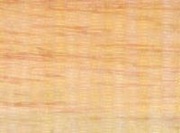Difference between pages "Ballas" and "Balsa"
(Difference between pages)
Jump to navigation
Jump to search
| Line 1: | Line 1: | ||
| + | [[File:Balsa MFA 2007442.jpg|thumb|Balsa model<br>MFA 2007.442]] | ||
| + | [[File:image 9-balsa.jpg|thumb|Balsa]] | ||
== Description == | == Description == | ||
| − | + | A very lightweight wood obtained from several trees of the Bombacaceae family, genus ''Ochroma'', such as ''O. pyramidale'' and ''O. lagopus''. Balsa trees are native to the Caribbean region, Central and South America. It is the lightest and softest wood used commercially. The white to tan-color, soft wood has a straight grain, coarse texture and is relatively strong. Balsa wood is easily carved and often used for model airplanes and toys. Balsa is also used as a substitute for [[cork]] in insulation, flats, life preservers, and buoys. | |
| + | |||
| + | See also [[balsa fiber]]. | ||
== Synonyms and Related Terms == | == Synonyms and Related Terms == | ||
| − | + | ''Ochroma pyramidale''; ''Ochroma lagopus''; balsatræ (Dan.); Balsabaum (Deut.); balsa (Fr., Sven., Esp., Port.); corkwood | |
==Physical and Chemical Properties== | ==Physical and Chemical Properties== | ||
| − | |||
| − | |||
| − | |||
| − | |||
| − | |||
| − | |||
| − | |||
| − | |||
| − | == | + | * Specific gravity = 0.12-0.2 (oven dry) |
| + | * Density = 7-12 ppcf | ||
| − | + | ==Resources and Citations== | |
| − | + | * G.S.Brady, ''Materials Handbook'', McGraw-Hill Book Co., New York, 1971 Comment: p. 82 | |
| + | |||
| + | * Ralph Mayer, ''A Dictionary of Art Terms and Techniques'', Harper and Row Publishers, New York, 1969 (also 1945 printing) | ||
| + | |||
| + | * F. H. Titmuss, ''Commercial Timbers of the World'', The Technical Press Ltd., London, 1965 | ||
| + | |||
| + | * Wikipedia: http://en.wikipedia.org/wiki/Balsa (Accessed Jan. 15, 2006) | ||
* ''Van Nostrand's Scientific Encyclopedia'', Douglas M. Considine (ed.), Van Nostrand Reinhold, New York, 1976 | * ''Van Nostrand's Scientific Encyclopedia'', Douglas M. Considine (ed.), Van Nostrand Reinhold, New York, 1976 | ||
| − | * '' | + | * Random House, ''Webster's Encyclopedic Unabridged Dictionary of the English Language'', Grammercy Book, New York, 1997 |
| + | |||
| + | * ''The American Heritage Dictionary'' or ''Encarta'', via Microsoft Bookshelf 98, Microsoft Corp., 1998 | ||
| + | |||
| + | * Gordon Hanlon, contributed information, 1998 | ||
| + | |||
| + | * ''CRC Handbook of Chemistry and Physics'', Robert Weast (ed.), CRC Press, Boca Raton, Florida, v. 61, 1980 Comment: density=7-9 ppcf (0.11-0.14 g/cm3) | ||
[[Category:Materials database]] | [[Category:Materials database]] | ||
Latest revision as of 17:09, 1 May 2022
Description
A very lightweight wood obtained from several trees of the Bombacaceae family, genus Ochroma, such as O. pyramidale and O. lagopus. Balsa trees are native to the Caribbean region, Central and South America. It is the lightest and softest wood used commercially. The white to tan-color, soft wood has a straight grain, coarse texture and is relatively strong. Balsa wood is easily carved and often used for model airplanes and toys. Balsa is also used as a substitute for Cork in insulation, flats, life preservers, and buoys.
See also Balsa fiber.
Synonyms and Related Terms
Ochroma pyramidale; Ochroma lagopus; balsatræ (Dan.); Balsabaum (Deut.); balsa (Fr., Sven., Esp., Port.); corkwood
Physical and Chemical Properties
- Specific gravity = 0.12-0.2 (oven dry)
- Density = 7-12 ppcf
Resources and Citations
- G.S.Brady, Materials Handbook, McGraw-Hill Book Co., New York, 1971 Comment: p. 82
- Ralph Mayer, A Dictionary of Art Terms and Techniques, Harper and Row Publishers, New York, 1969 (also 1945 printing)
- F. H. Titmuss, Commercial Timbers of the World, The Technical Press Ltd., London, 1965
- Wikipedia: http://en.wikipedia.org/wiki/Balsa (Accessed Jan. 15, 2006)
- Van Nostrand's Scientific Encyclopedia, Douglas M. Considine (ed.), Van Nostrand Reinhold, New York, 1976
- Random House, Webster's Encyclopedic Unabridged Dictionary of the English Language, Grammercy Book, New York, 1997
- The American Heritage Dictionary or Encarta, via Microsoft Bookshelf 98, Microsoft Corp., 1998
- Gordon Hanlon, contributed information, 1998
- CRC Handbook of Chemistry and Physics, Robert Weast (ed.), CRC Press, Boca Raton, Florida, v. 61, 1980 Comment: density=7-9 ppcf (0.11-0.14 g/cm3)

